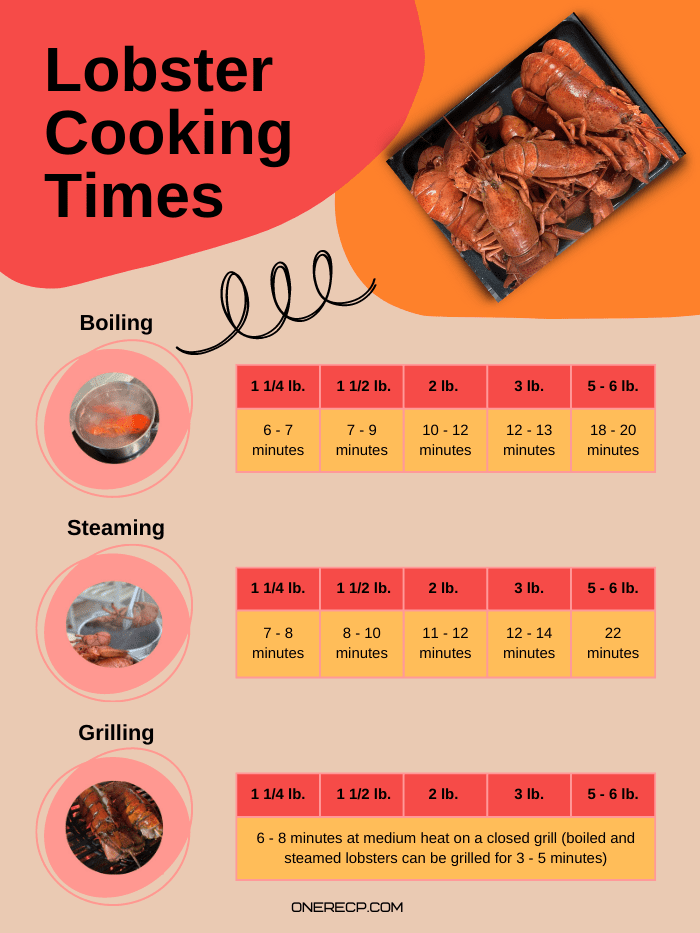When I first began cooking shellfish, I always got annoyed by ambiguous recipe instructions such as ‘cook until it’s done’.
After all, how are you supposed to tell when a lobster is done, when you don’t know its minimum internal temperature?
This annoyance prompted me to do some research and find out at what temperature a lobster is considered fully cooked.
What’s the minimum internal cooking temperature for a whole lobster?
Even though lobsters are a type of seafood, they don’t adhere to the same internal temperature guidelines as fish.
This is because the texture of their meat is actually much closer to that of beef than fish.
Unlike fish, lobsters have long muscle fibers that can withstand higher temperatures.
As a result of this, their meat has a dense texture that doesn’t fall apart under high heat.
This allows lobsters to be prepared in a variety of ways such as boiling, grilling, steaming, or even broiling.
Each of these methods applies heat differently, but they’re all used to achieve the same level of doneness.
This naturally brings the question at what internal temperature is a lobster considered safe to eat.
According to the USDA, lobsters should be cooked to a minimum internal temperature of 145°F. This will destroy any pathogens or potentially harmful microorganisms and make their meat safe for consumption. To measure the temperature of a lobster, insert a meat thermometer at the base of its tail.
It should be noted that some people prefer to cook their lobsters to 130 – 135°F (54 – 57°C) because it gives lobster meat a firmer texture.
This could come in handy if you want to make some lobster rolls that taste just like the ones at a lobster shack.
On the other hand, lobster meat can also be cooked to temperatures higher than 145°F.
However, in these cases the meat tends to develop a rather rubbery and unappetizing texture.
Since you can easily ruin an expensive lobster by either undercooking or overcooking it, it’s best to stop cooking once your thermometer hits 145°F.
If you’re boiling or steaming, you should also throw the lobster in an ice bath right after you take it out of the pot. This will prevent the meat from cooking further and becoming chewy.
How long should you cook a lobster?
The amount of time you need to cook a lobster will depend on its weight and the way it is prepared.
Since the combination of these variables creates different cooking times, I decided to summarize the data in a table.
The time estimates are sorted according to the cooking method and approximate weight of an individual lobster.

If you’re boiling or steaming, you should start recording the time once the water comes to a boil.
Another factor that can affect cooking times is the type of lobster you’re cooking.
Soft-shelled lobsters have a thinner shell, so their cooking time should be decreased by 2 to 3 minutes.
If you’re making grilled lobster, then you’ll notice that the tails cook a bit faster than the claws.
Grilled lobster tails are typically done in 6 minutes, while the claws require an extra minute or two.

by Wanasmoke
These figures should serve only as a guideline since there are a number of other factors that can affect how fast a lobster cooks.
You should always use a thermometer to check whether yours has finished cooking.
What could happen if you eat an undercooked lobster?

by GlennM
Just like any other type of shellfish, lobsters can cause food poisoning when they’re not prepared at the right temperature.
Eating raw or undercooked lobster meat is commonly associated with the following health conditions:
- Bacterial Infection – One of the most common culprits behind seafood poisoning is a type of bacteria called Vibrio. These bacteria are typically found in the coastal waters of the United States and Canada where they coexist with lobsters.
So when you eat an undercooked lobster or any other type of shellfish, there’s a high chance these bacteria are already present in their system.
Once they enter our bloodstream, vibrio bacteria cause a bacterial infection also known as Vibriosis. Some of the most common symptoms of Vibriosis are:
- Diarrhea
- Nausea
- Stomach cramps
- Vomiting
- Fever
You should seek medical attention if you begin to experience any of these symptoms 12 to 24 hours after eating shellfish.
Vibrio bacteria are also the primary reason why lobsters need to be cooked right after they die. When a lobster dies, these bacteria start to multiply rapidly, eventually colonizing its entire body.
And once they’ve settled in, they’re nearly impossible to get rid off.
- Parasitic Infection – Another possible health complication that might arise from consuming undercooked lobster meat is a parasitic infection. The two most common types of parasites that lead to such infections are roundworms and tapeworms.
If they don’t get caught early on, these infections might lead to severe nutritional deficiency and weight loss.
Some of the other symptoms include bloating, diarrhea, gas, anemia, and constipation.
- Hepatitis – Despite their high cost, lobsters yield only 20% of their total body weight as meat while the rest is mostly salt water that evaporates during cooking. So If the lobster at your dinner table has been caught from an area of water that has been contaminated with hepatitis A, there is a chance it might carry the virus.
Hepatitis is a chronic health condition that may be unnoticed for years until the first symptoms begin to surface.
It can seriously damage liver function and even lead to acute liver failure.
- Salmonella – Even though Salmonella doesn’t typically originate from seafood, it can be transmitted to it through inadequate handling or contaminated water. The first signs of Salmonella infection might appear anywhere from six hours to six days after consumption.
The most commonly reported ones are stomach cramps, diarrhea, and fever.
To minimize the risk of Salmonella poisoning, remember to always wash your hands, keep your preparation areas clean and cook your lobster to an internal temperature of 140°F.
My Summary
Cooking a lobster can be much simpler than it’s made out to be if you know how to tell when it’s done.
The most important thing you need to remember is to always use an instant thermometer to measure its internal temperature.
If you do this, you can rest assured your lobster will always turn out the way you intended.
Stay tuned for more tips and tricks from the cooking world and don’t forget to check out my lobster recipe below.
If seafood is what you’re after, try one of these next: